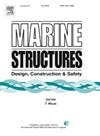Numerical analysis on the creep-fatigue damage of titanium alloy deep-sea pressure hull at room temperature
Abstract
Titanium alloy deep-sea pressure hull suffers from room-temperature creep-fatigue problem. Room-temperature creep damage significantly reduces the fatigue life of titanium alloy deep-sea pressure hull. In order to analyze the room-temperature creep-fatigue failure process of titanium alloy pressure hull, a room-temperature creep-fatigue damage model in three-dimensional stress space is proposed. Numerical simulation of the model is implemented based on the finite element method. The accuracy of the proposed damage model as well as the numerical method is verified by carrying out the creep-fatigue crack propagation test on CT specimen of titanium alloy at room temperature. It is concluded that the proposed damage model and numerical method can accurately describe the room-temperature creep-fatigue failure process of titanium alloy structures. Creep-fatigue hotspot of the cone–cylinder pressure hull is located on the tensile side of the outer wall. The creep damage accumulated during the crack initiation stage needs to be considered when analysing creep-fatigue crack propagation process of pressure hull. The creep-fatigue cracks propagate in the circumferential and radial directions from the point of initiation. In the later stage, the circumferential propagation rate is significantly faster than the radial propagation rate. The crack surface develops into a long stripe.

 求助内容:
求助内容: 应助结果提醒方式:
应助结果提醒方式:


